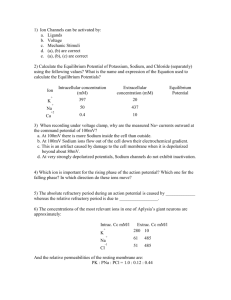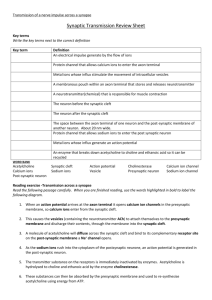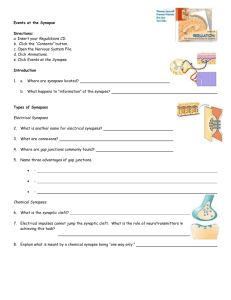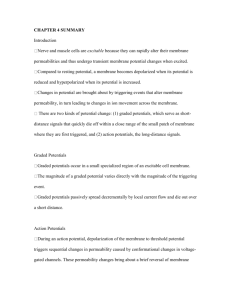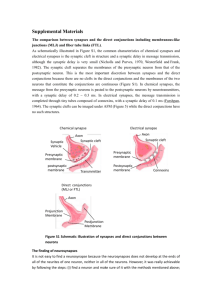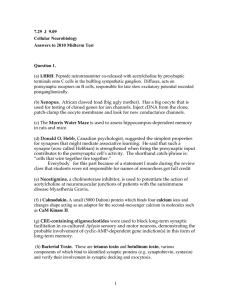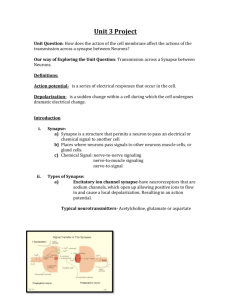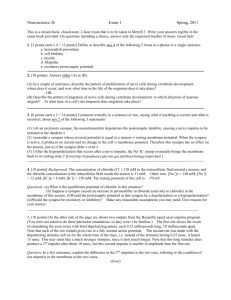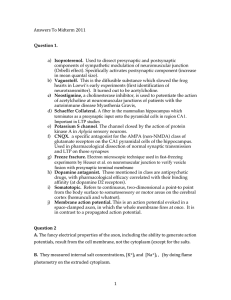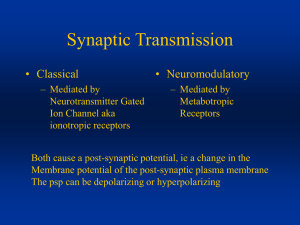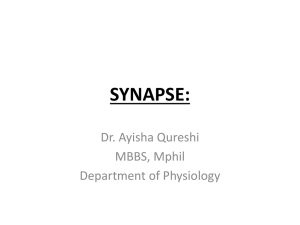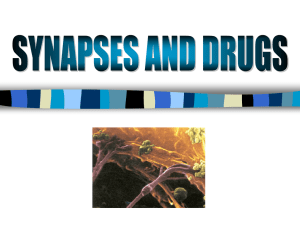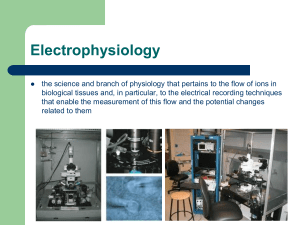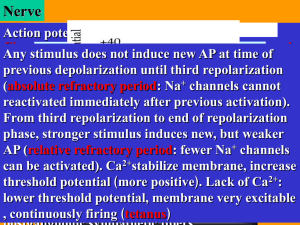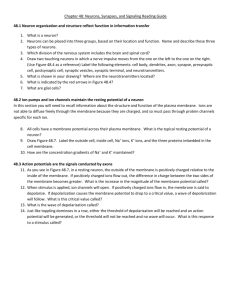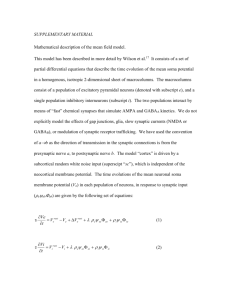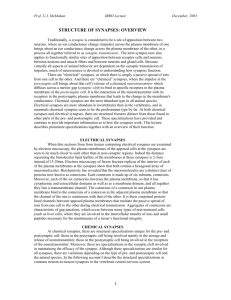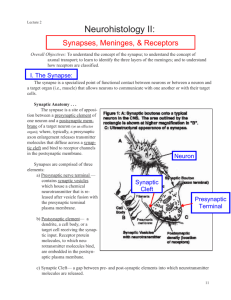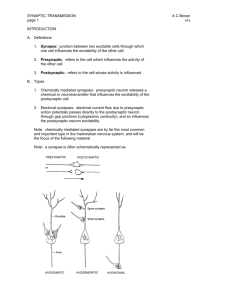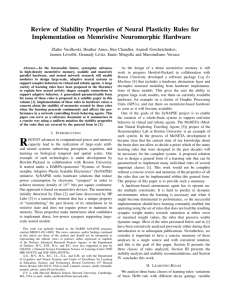4-Calculate the Equilibrium Potential of Potassium, Sodium, and
advertisement
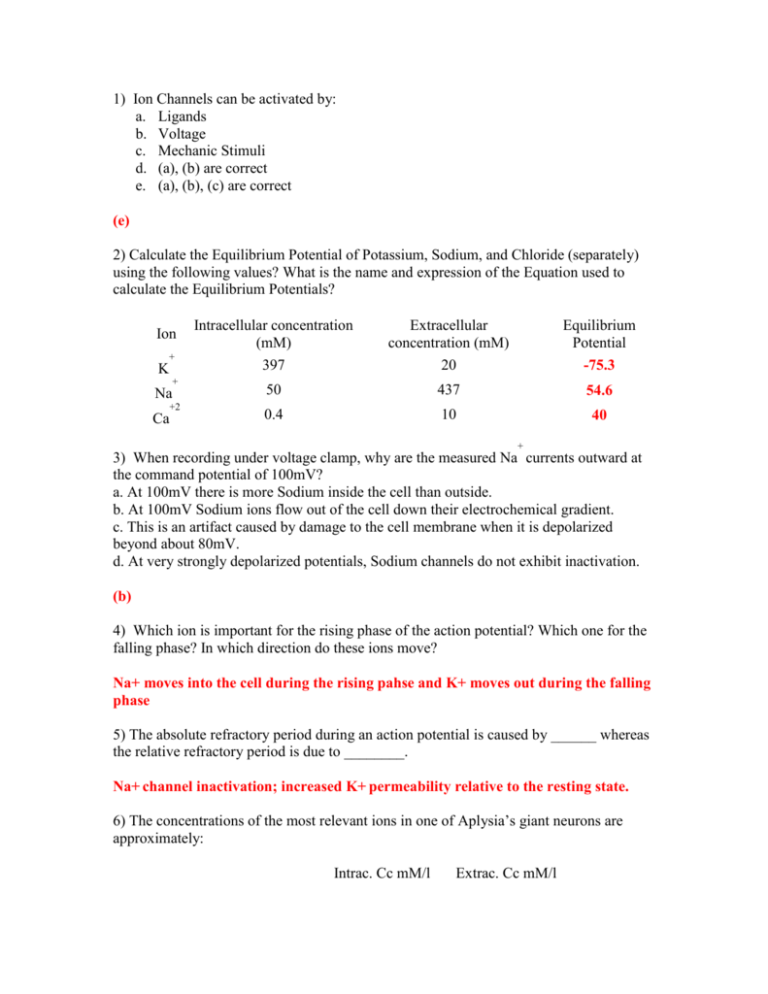
1) Ion Channels can be activated by: a. Ligands b. Voltage c. Mechanic Stimuli d. (a), (b) are correct e. (a), (b), (c) are correct (e) 2) Calculate the Equilibrium Potential of Potassium, Sodium, and Chloride (separately) using the following values? What is the name and expression of the Equation used to calculate the Equilibrium Potentials? Ion + K + Na +2 Ca Intracellular concentration (mM) 397 Extracellular concentration (mM) 20 Equilibrium Potential 50 437 54.6 0.4 10 40 -75.3 + 3) When recording under voltage clamp, why are the measured Na currents outward at the command potential of 100mV? a. At 100mV there is more Sodium inside the cell than outside. b. At 100mV Sodium ions flow out of the cell down their electrochemical gradient. c. This is an artifact caused by damage to the cell membrane when it is depolarized beyond about 80mV. d. At very strongly depolarized potentials, Sodium channels do not exhibit inactivation. (b) 4) Which ion is important for the rising phase of the action potential? Which one for the falling phase? In which direction do these ions move? Na+ moves into the cell during the rising pahse and K+ moves out during the falling phase 5) The absolute refractory period during an action potential is caused by ______ whereas the relative refractory period is due to ________. Na+ channel inactivation; increased K+ permeability relative to the resting state. 6) The concentrations of the most relevant ions in one of Aplysia’s giant neurons are approximately: Intrac. Cc mM/l Extrac. Cc mM/l + 280 10 K + Na -1 Cl 61 485 51 485 And the relative permeabilities of the resting membrane are: PK : PNa : PCl = 1.0 : 0.12 : 0.44 What is the value of the resting potential, as estimated using the GHK equation? The resting potential is about -43mV 7) In the circuit model of a neuron, channels are represented as conductances, the electromotive forces as batteries and the cell membrane as a capacitance. (a) Draw the equivalent circuit for a neuron containing Sodium and Potassium Channels. (b) Calculate the resting potential of the cell in the steady state (i.e. when the capacitor has already been charged, and thus can be ignored). + -6 + -6 gNa =0.5x10 S ; gK =10x10 S ; ENa= 55mV ; Ek= -75mV The Resting Potential will be equal to -69mV. 8) Define and explain the space constant. What does it depend on? The space constant (λ) is the length in the fiber from the site of current injection to when the voltage has decayed to 37% of its initial value. It can be calculated as: λ=(Rm/Ri) 1/2 Where Rm is the membrane resistance and Ri the axial or internal resistance (i.e. the resistance of the intracellular space to the flow of ions). The space constant is a good measure of how fast or slow will current flow though an axon. (the larger the space constant, the faster the conduction). There are at least two ways of increasing the space constant: • By increasing Rm, which means, making the cell membrane less permeable to ions. (This is what happens in myelinated axons, for example. So myelination increases the conductance speed) • By decreasing the Ra (also called Ri or internal resistance). This can be done by increasing the axon’s diameter. 9) Mark True or False: a. Action potential conduction down the axon involves passive current flow. TRUE. At the leading edge of the action potential, there is a capacitive current which is responsible for depolarizing the area of the membrane, allowing the activation of voltage gated channels and, in this way, the propagation of the action potential. Once the voltage gated channels open, the propagation becomes active. b. Poisoning the Na-K ATPase pump in a neuron would lengthen the refractory period. FALSE. The refractory period is explained by the inactivation of voltage-gated Na channels and the delayed opening of the voltage gated K+ channels. The Na-K ATPase, is responsible over the long term for maintaining the concentration gradients of these two ions, but blocking it would not have a noticeable effect immendiately and as time passed, there would be both a decrease in the peak value of the action potential and a slow down of both the rising phase and the falling fase. The refractory period would not be significantly affected. c. Oligodendrocytes secrete the myelin that surrounds the neurons in the peripheral nervous system. FALSE. For two reasons: 1) Oligodendrocytes myelinate central nervous system neurons, in the peripheral nervous system, Schwann cells are responsible for myelination. 2) Oligodendrocytes provide the myelin to the neurons in the central nervous system not by secreting myelin, but by surrounding the axons themselves. d. While action potential conduction is in ‘jumps’ (Saltatory Conduction) in myelinated axons, conduction in non-myelinated axons is continuous. TRUE. 10) match the technique to the desired experiment: a) examining currents in post synaptic cell ________ b) examining conductance of single ion channel ________ c) examine effect of squirting protease on inside of channel ________ d) examine quantal synaptic events ________ 1- stimulate presynaptic cell with low [Ca2+] extracellular solution 2- whole-cell voltage clamp 3- inside-out patch clamp 4- patch clamp (in voltage clamp) a) 2 b) 4 c) 3 d) 1 11)- Define/Explain: a. Synaptic Cleft – At chemical synapses, neurons are separated completely by a small space called the synaptic cleft. b. Neurotransmitter – A chemical signal transmitted by one presynaptic neuron that travels across the synaptic cleft to bind to its receptor on a postsynaptic cell. (Remember the different criteria to define a substance as Neurotransmiter) c. Chemical synapse – At chemical synapses, a cleft separates two cells and the cells do not communicate through bridging channels. At the chemical synapse, a change in the membrane potential of the presynaptic cell leads to the release of a chemical transmitter from the nerve terminal. The transmitter diffuses across the synaptic cleft and binds to receptor molecules on the postsynaptic membrane, thus opening ion channels through which current flows. d. Electrical synapse – An electric synapse consists of a presynaptic terminal that is joined to the postsynaptic cell via specialized channels called gap junctions, which physically connect the cytoplasm of the presynaptic and postsynaptic cells. An action potential generated in the presynaptic neuron then flows directly into the postsynaptic cell through the gap junctions. (remember differences between chemical and electric synapses) e. Neuro-Muscular Junction –The neuromuscular junction (a well studied junction) consists of a presynaptic neuron terminal that releases acetylcholine (ACH) and the endplate of the postsynaptic muscle cell, where there are abundant nicotinic acetylcholine receptors. These channels bind ACH and then produce a depolarizing signal that in turn recruits voltage-gated sodium channels. The presynaptic side has plenty of voltage-gated Ca2+ channels (Remember that calcium is needed for vesicle releae) and the cleft has acetylcholine-esterase on the basement membrane that breaks acetylcholine down for recycling. f. Quanta. (in relation to synaptic transmission) – Neurotransmitters at the chemical synapse are released in discrete packages called quanta. Each quantum of transmitter produces a postsynaptic potential of a fixed size called the quantal synaptic potential. 12) These are the recordings obtained from a patch of membrane that contained a single channel. During the experiment the concentration of the ion that this channel is selective for was kept constant and equal on both sides of the channel, and the voltage across the patch was changed systematically. a) Draw the IV-curve for this channel in these conditions. b) Estimate the channel’s conductance. (Be careful with the units). The channel’s conductance will be approximately: 0.1nS. 13) You are conducting experiments with a patch-pipette in the cell-attached conformation. With this configuration, you can change the membrane voltage for that patch and record the current that flows through that patch. You do the experiment in 3 different patches (A, B, C) and obtain the following results: Note: This is a QUALITATIVE problem, so do not focus on the exact numbers (if you tried to do an IV curve with these data points, it would look very weird), just look at general trends. a) How can you explain the results for experiment A? How could you test this hypothesis? (all suggestions are welcome, the crazier the better! ) The results in A suggest that there were no channels in the patch of membrane extracted from the cell. Any experiment you could suggest, as longs as plausible, would be considered OK. b) What type of channel did you have in your patch in cases B and C? What additional voltage step should you have done in each of those experiments to be sure? What would you expect to see in each case? I would think that in B I had a potassium channel, since it seems to reverse its currents around the Ek value. In case C, I would suspect that I had a sodium channel since it seems to revert its currents around ENa.
